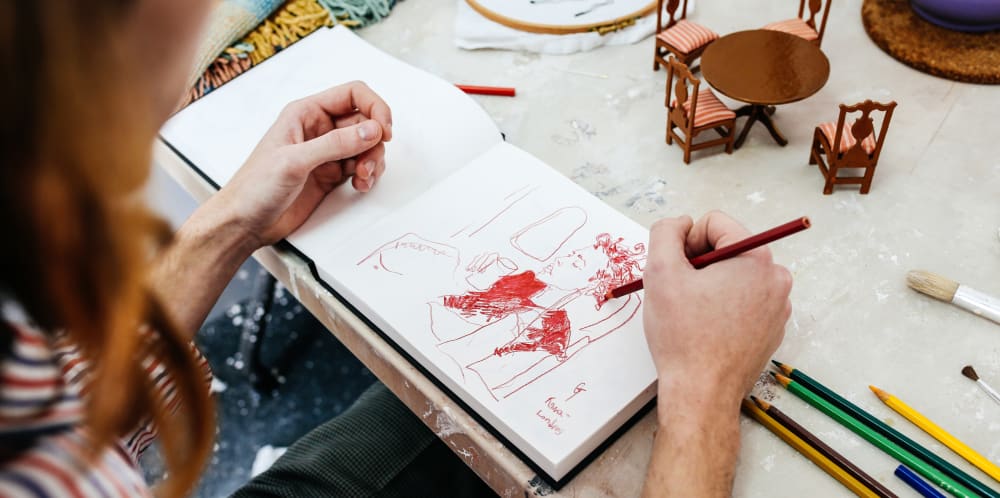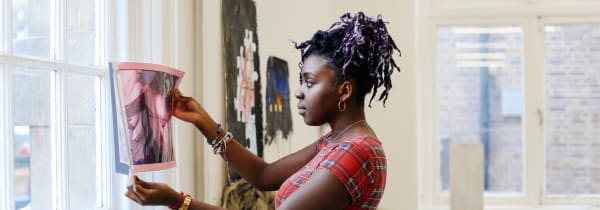
This advice is for UAL students who are studying, working and creating in their own home. We want you to be safe and well while doing anything that is part of your course.
If you live in halls of residence, you can get advice from the Accommodation Team at accommodation@arts.ac.uk
If you are living in private rented accommodation, you should check the terms of your lease or speak to your landlord.
Contact us
If you have any questions, concerns or doubts, you should contact your Course Leader or Technical Team.
If you need further help, you can email your Health and Safety Advisor:
- Chelsea, Camberwell and Wimbledon: Karen Bolan, k.bolan@arts.ac.uk
- Central Saint Martins: Jack Panton, j.panton@arts.ac.uk
- London College of Communication: Nathan Harris, nathan.harris@arts.ac.uk
- London College of Fashion: Roland Philbert, r.philbert@arts.ac.uk
Reporting accidents
If you have an accident while working from home, you should let your Course Leader know as soon as possible.
Staying safe when working from home
We do not expect you to do anything that would usually take place safely and without risk in a UAL workshop or studio.
To help you decide what you can do safety, this advice is structured by level of risk.
These are just some examples, so get in touch if you're not sure.
Lower-risk activities
These activities are lower risk because they don't involve machinery, hazardous substances, flammable materials, etc. You can do these at home but do take care.
- Collage using paper, fabrics and pieces of plastic, wood, metal, etc., and water-based glue.
- Digital animation
- Digital film-making
- Digital photography
- Drawing and sketching using pens, pencils, crayons, pastels, chalks and charcoal.
- Embroidery, hand sewing and weaving on a small domestic loom.
- Hand modelling using clay or plasticine.
- Using manual hand tools, such as screwdrivers, hammers, manual staple guns.
- Painting using watercolour or acrylic paints.
- Printing on or colouring paper or fabric using water-based inks and dyes.
- Using domestic scissors, pinking shears and craft knives.
- Working on ultra-low voltage electrical circuits.
- 2-D and 3-D printing using domestic printers.
Medium-risk activities
These activities are likely to involve some risk to you and, sometimes, to the people you live with. Please keep yourself and other people safe.
Using a computer, laptop, device or sewing machine
Working at a piece of equipment for a long time, especially if it is badly laid out and you are sitting poorly, can injure you. When working, you should take a break every 20 minutes.
Watch these videos on how to use a laptop safely at home and how to set up a workstation at home.
Using electrical equipment
The electrical supply to our homes can cause serious harm and start fires. Never use damaged electrical equipment, and switch everything off when you’re not using it.
Before using any electrical equipment:
- check there are no exposed wires
- check that the cables are not frayed, cut or damaged.
Use an extension lead that is long enough and only plug it into a socket – not into another extension lead.
Using hazardous substances
Hazardous substances include anything that is:
- an irritant
- corrosive
- explosive
- flammable
- harmful to health
- toxic.
Explosive and flammable substances include spray paints, adhesives and other materials that can ignite. Never used these around naked flames including candles, gas cookers and lighters.
Irritants can make you ill if you breathe them in. Try to use them in the open air, or in a room with a window open.
Please follow the manufacturer’s instructions at all times.
Higher-risk activities
You should not do these activities or use these substances at home without first speaking to your Course Leader and/or Technical Team and carrying out a risk assessment.
- Working at height, including using ladders and standing on chairs or desks.
- Using these flammable and harmful substances:
- acids
- alkalis
- chemical adhesives and solvents
- dry ice
- film processing/dark room chemicals
- petrol and diesel
- white spirit.
- Anything involving heat, flames or the risk of fire/explosion, including:
- acetylene
- candles
- linseed oil
- gas or electric heat guns
- propane
- welding.
- Weapons, such as knives, firearms (including replicas) and ammunition.
- Lasers.
- You or somebody else being under, over or in water.
- Electrical circuits (with the exception of extra-low voltage).
- Soldering.
More information
-

© Alys Tomlinson, Emanuela Ogunji working in the Studio, BA (Hons) Fine Art, Chelsea College of Arts.
Health and wellbeing
Take care of yourself and our community. Read our advice and tips.